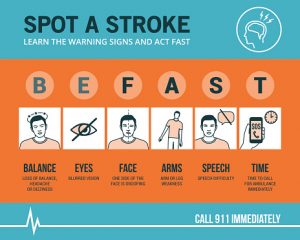 For those at risk, a stroke can occur at any moment. It occurs when a blood vessel in the brain becomes blocked, restricting oxygen-rich blood from reaching brain cells. Strokes are the third leading cause of death in the United States, with more than 140,000 people dying from the event every year. If death does not occur, severe long-term disability is often a result. While it is more common to suffer from a stroke in the later years of our lives, it can happen at any age.
For those at risk, a stroke can occur at any moment. It occurs when a blood vessel in the brain becomes blocked, restricting oxygen-rich blood from reaching brain cells. Strokes are the third leading cause of death in the United States, with more than 140,000 people dying from the event every year. If death does not occur, severe long-term disability is often a result. While it is more common to suffer from a stroke in the later years of our lives, it can happen at any age.
These are just some of the reasons we at Bel Marra believe strokes are a major issue our readers should be aware of. To better get you up to speed we have compiled a list of our most informative articles on the subject. You will find information on massive stroke, stroke and its relation to liver disease, as well as stroke recovery. To help clear up any confusion, we have also included information on stroke versus heart attack.
Massive stroke: Signs, treatment, and recovery tips
Advertisement
When the blood flow to an area of your brain is inhibited, you experience a stroke. The lack of blood causes your brain cells to starve for oxygen, ultimately resulting in their death. A massive stroke, however, is more serious and results in severe brain damage or death. By massive we mean that a huge area of the brain was affected and a lot of damage was done.
According to the Centers for Disease Control and Prevention, strokes are the third leading cause of death in the U.S. This is unfortunate, as strokes are largely preventable through a healthy lifestyle. However, we usually don’t take preventative measures until it’s too late. Continue reading…
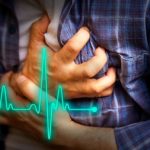 Naturally occurring protein protects against heart attack and stroke: Study
Naturally occurring protein protects against heart attack and stroke: Study
Clutching our chest as we collapse to the ground is something we all fear as we get older, as a heart attack can occur suddenly and without warning. It happens because the flow of blood to the heart has become blocked, most often due to a buildup of fat, cholesterol, and other substances that have accumulated throughout the years.
People have long been advised that to keep these artery-clogging substances at bay and avoid a heart attack, they should maintain a healthy diet and exercise regularly.
However, a new study finds that a naturally occurring protein called dickkopf-related protein 3 (DKK3) could guard against heart attacks and strokes. It has shown promise in stopping the buildup of fatty material inside the arteries associated with atherosclerosis. Continue reading…
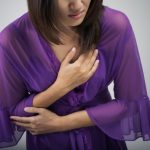 Stroke vs. heart attack: How do you know if you’re having a stroke or heart attack?
Stroke vs. heart attack: How do you know if you’re having a stroke or heart attack?
Understanding the differences between a stroke and a heart attack can help you get the appropriate help. They are both medical emergencies and can alter a person’s life, yet a stroke and heart attack are not exactly the same.
While they may be related, there is a difference between a stroke and a heart attack. Sadly, about every 43 seconds, someone in the United States suffers a heart attack. Approximately 800,000 Americans experience a stroke every year. So, how do we explain what distinguishes a stroke from a heart attack? Well, a heart attack happens when blood flow to part of the heart becomes blocked. Without oxygenated blood, heart muscles start to die. However, in the case of a stroke, the brain is impacted. The brain attack occurs when blood flow and oxygen to the brain is cut off. This can take place if a blood vessel that feeds the brain gets clogged or bursts. Continue reading…
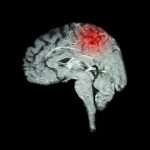 Liver disease linked to stroke: Study
Liver disease linked to stroke: Study
The liver is just one of many important organs in the human body. It is actually vital for our survival, as we would die if it became compromised in any way. The liver has a wide range of functions, including detoxification of blood to the production of a biochemical needed for digestion. That’s why liver cirrhosis can be life threatening, and according to new research, it can even lead to hemorrhagic strokes. Continue reading…
Understanding stroke rehabilitation: Exercise tips for stroke recovery
Advertisement
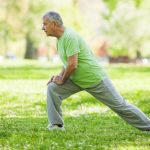 Stroke rehabilitation often involves exercises to improve post-stroke recovery. This is because many motor skills can become affected after a stroke, depending on what area of the brain is affected. For example, patients may need to redevelop their ability to walk or even use their hands.
Stroke rehabilitation often involves exercises to improve post-stroke recovery. This is because many motor skills can become affected after a stroke, depending on what area of the brain is affected. For example, patients may need to redevelop their ability to walk or even use their hands.
Rehab is often conducted alongside a physiotherapist who will work closely with you to improve mobility. They may also provide you with exercises to complete at home in order to boost your abilities and ensure you become stronger more quickly.
Rehabilitation exercises are often repetitive in nature. This is because in order for the brain to rewire itself, these activities must be repeated over and over to teach the brain what to do. This process is known as neuroplasticity. Continue reading…
